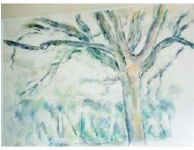by Lynda Albertson, ARCA CEO
Each year, The Association for Research into Crimes against Art honors distinguished and emerging writers specializing in art crime and cultural heritage preservation, inviting them to Amelia, Italy as the Association's annual Writer in Residence. Designed to promote critical and reflective writing and funded by ARCA supporters, The Amelia Writer in Residence Program reflects ARCA's belief that the basis for any critical and comprehensive writing involves the opportunity for contemplation, research, collaboration and support.
By hosting writers in residence, ARCA strives to create an intellectually stimulating home base for an author's literary and research activities. Throughout this residence, the writer spends most of his or her time working on a literary project but also contributes to the intellectual community of ARCA's postgraduate certificate program in Art Crime and Cultural Heritage Protection. By sharing their scholarship and professional experiences, their presence and contribution has meaningful impact on this specialized didactic program.
The Writer-in-Residence is chosen from candidates proposed by a Nominations Subcommittee, whose members have been selected by ARCA trustees and faculty. The Nominations Subcommittee proposes candidates whose work and character are known to them and selection is made by group consensus predicated on a writer's professional standing in his or her field of specialization. Heavy emphasis is placed on projects that promote and foster interdisciplinary cooperation in art protection and recovery. While in Italy authors are asked to contribute keynote lectures or to present at ARCA's Annual Art Crime conference enriching the dialogue by speaking about their manuscript project or a topic of mutual professional interest to scholars and students in
attendance.
For 2012 ARCA is pleased to announce that our third annual Writer-in-Residence will be Dr. Laurie Rush.
Dr. Laurie Rush has a BA from
Indiana University in Bloomington, Indiana, Summa Cum Laude, and an MA and PhD from
Northwestern University in Evanston, Illinois where she was a fellow of the University and of the National Science Foundation.
Teams working with Dr. Rush have discovered over one hundred fifty Native American archeological sites on Fort Drum including one dating back over 10,000 years and another documenting earliest French contact in the region. Her research on the possibility for paleo-maritime culture in the Great Lakes has been recognized by eminent archaeologists as having potential for better understanding of the peopling of the Americas. As part of her Fort Drum responsibilities Dr. Rush also established consultation partnerships between the installation and three Haudenosaunee Nations, the Oneida Indian Nation, the Onondaga Nation, and the St. Regis Mohawk Tribe.
Dr. Rush was the Booth Family Rome Prize winner for 2010-2011 in Historic Preservation at the American Academy in Rome. She is also winner of numerous military and collegial awards including the 2007 Chairman's Award for Federal Achievement in Historic Preservation, the 2009 Register of Professional Archaeologists Distinguished Service to the Field, and in 2007 and 2009 Manager of the Best Cultural Resources Program and Team in the US Department of Defense. Dr. Rush also recently served on the American Anthropology Association Ad Hoc Commission on the Ethics of Engaging with the Security and Intelligence Communities.
In 2009, Major General Oates requested that Dr. Rush serve as the military liaison for the successful return of the Ancient City of Ur to Iraqi stewardship, and in 2010, Dr. Rush traveled to Kabul with Central Command personnel to participate in Environmental Shuras and to meet with the Director General of Heritage for the Islamic Republic of Afghanistan and US State Department officials on behalf of establishing increased awareness and military partnership for preservation projects in Kabul and Mes Aynak. This participation resulted in allocation of over one million dollars by the US Army Corps of Engineers to support artifact conservation at the ancient Buddhist City of Mes Aynek.
As the Director of the In Theater Heritage Training Program for Deploying Personnel, Dr. Rush helped to establish a partnership between the Archaeology Institute of America and the Department of Defense. This project, funded by the OSD Legacy Resource Management Program and implemented in cooperation with Colorado State University, produced archaeology awareness playing cards for Iraq, Afghanistan, and Egypt; Soldier pocket cards in multiple languages; replica archaeological sites for military training; educational presentations for military personnel; Central Command regulations for protection of cultural property, detailed archaeology maps for Iraq and Afghanistan, heritage reference websites for military personnel, and archaeology construction checklists for military engineers. These accomplishments helped to build the US Combat Command Historical Cultural Action Group that is now working at the global level toward improved archaeology mapping for military planning and establishing military guidelines for stability operations in archaeologically sensitive areas. She is also a founding member of the International Military Cultural Resources Working Group that participated in the recent cultural property inspections in Libya.
Dr. Rush is editor of the recently released volume, Archaeology, Cultural Property, and the Military and has an article forthcoming in the journal Military Review that focuses on lessons today's US personnel can learn from the accomplishments of the Monuments Officers of World War II.
We hope the ARCA community will embrace and support Dr Rush as this year's invited Writer in Residence.
 Cezanne,Interpol,Serbia,stolen art database,Zurich
Cezanne,Interpol,Serbia,stolen art database,Zurich
 No comments
No comments
 Cezanne,Interpol,Serbia,stolen art database,Zurich
Cezanne,Interpol,Serbia,stolen art database,Zurich
 No comments
No comments















